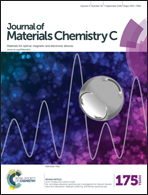Bifunctional resistive switching behavior in an organolead halide perovskite based Ag/CH3NH3PbI3−xClx/FTO structure†
Abstract
Organolead halide perovskite materials open up a new era for developing low-cost and high efficiency solar cells due to their simple and inexpensive fabrication process, superior light absorption coefficient, and excellent charge mobility. In addition to solar cells, hybrid perovskites have also seen dynamic advances with rapidly expanded applications to many other exciting fields including electronic and optical devices. Here, we demonstrate a new type of bifunctional resistive switching memory device based on a very simple bilayer structure of Ag and a CH3NH3PbI3−xClx perovskite material on an FTO substrate with both digital and analog resistive switching characteristics. The bi-stable resistive switching behavior with reliable endurance over 103 times and a retention time of 4 × 104 s demonstrates that the Ag/CH3NH3PbI3−xClx/FTO device can be a promising candidate for RRAM. In the low voltage sweeping region, surprisingly, analog resistive switching behavior with potentiation and depression characteristics was also observed, which can be useful in neuromorphic computing device applications. The possible Ag conducting filaments formed by redox reactions of the Ag electrode may play a key role in this newly observed resistive switching phenomenon.


 Please wait while we load your content...
Please wait while we load your content...